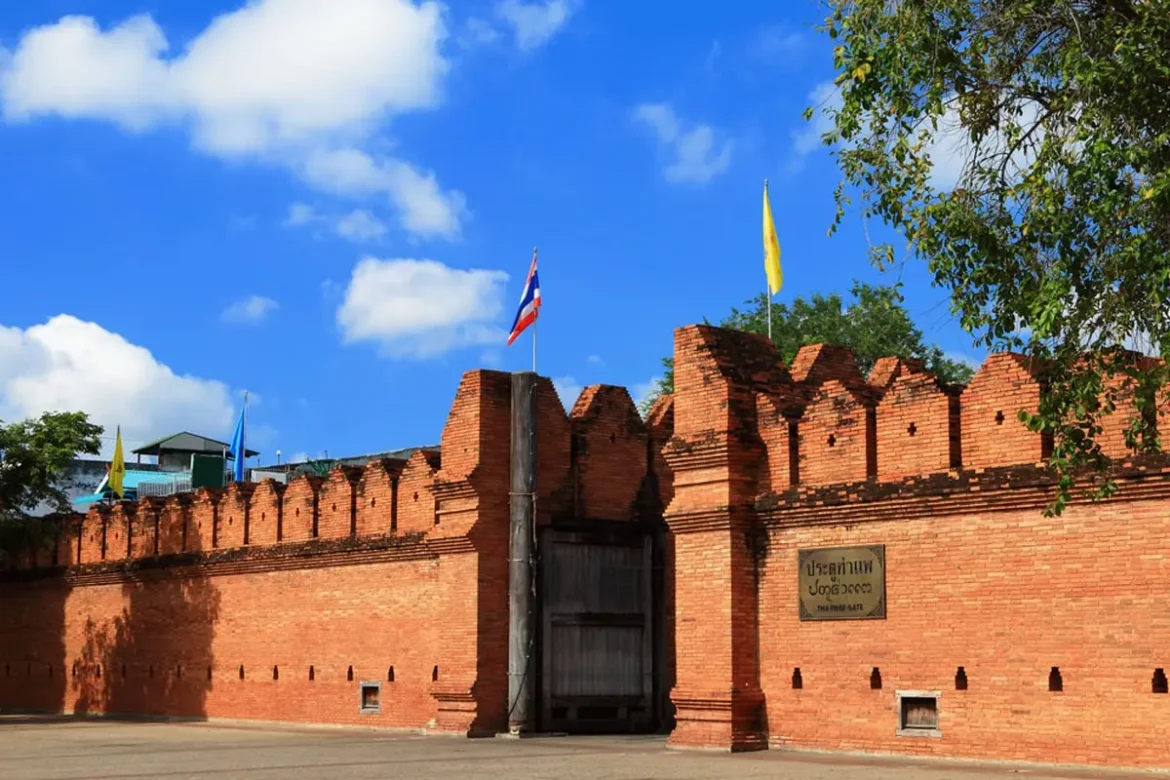Table of Contents
Tha Phae Gate is a historically significant site in Chiang Mai, Thailand. It is one of the best-preserved city gates on Chiang Mai’s historic city walls. As a result, it is a popular tourist destination and the focal point of the ancient city.
The Lanna Kingdom established Chiang Mai City as its new capital in 1296. King Mengrai constructed the square-shaped city, encircled by a protective wall and moat. This gate, formerly known as Chiang Ruak Gate, was one of the principal entrances to the walled city.
Today, the gate and adjoining square are a swarm of activity, hosting markets, events, and intriguing places. Let’s have a peek at what to expect when you visit this ancient site.
History and Culture
The construction of Tha Phae Gate is believed to have occurred in the early 13th century, shortly after the establishment of the city. Its original function was to act as a defensive fortification against the Mongols and Burmese, enabling limited access to the city while shielding it from prospective attacks. The gate is one of the city’s five ancient gates, positioned on the eastern side of the old city walls.
Historically, this historic gate was important for the city’s transportation and trade. Tha Phae translates to “raft landing.” It served as a major hub for merchants, dealers, and passengers entering or exiting Chiang Mai. The gate also served as a checkpoint for the examination and taxation of products.
As the city grew beyond its fortifications, the gate lost its military and defensive function and degraded over time due to material theft. They dismantled the exterior wall, leaving only the interior wall intact. However, it remained culturally and symbolically significant to the local inhabitants, and the community supported its rebuilding.
Today, Tha Phae Gate is a recognisable sign of Chiang Mai’s rich history and cultural heritage. It has become a famous tourist destination and a gathering area for both locals and visitors. Stores, cafes, and street vendors bustle in Tha Paegate Square, the area surrounding the gate.
Furthermore, this area of the old town is frequently the starting place for traditional festivals and processions in Chiang Mai. It is a popular gathering spot for locals during major festivals like New Year’s or Yi Peng. They release floating lanterns into the sky throughout the event.
Exploring Tha Phae Gate.
The original wall and Tha Phae Gate have undergone several renovations and changes over the years. Initially, the construction used a combination of brick and laterite, a local rock type. The gate incorporates architectural aspects of the Lanna and Burmese styles, signifying the historical and cultural interchange between the two kingdoms.
Tha Phae Gate’s most prominent features and design characteristics are the following:
- The Phae Gate main gate, battlements, and fortress comprise the three parts of the rectangular gate building. Two large walls flanked the gate, forming a majestic entryway.
- At each corner of the gate, there are two towering structures known as “prang.” These towers have both decorative and utilitarian purposes.
- Extensive sculptures illustrating Buddhist mythology, religious symbols, and exquisite flower designs adorn Tha Phae Gate. These carvings demonstrate the artists’ artistic abilities and meticulous attention to detail.
- The balustrades on either side of the gate have finely sculpted naga (serpent) sculptures. Southeast Asian culture commonly associates these mythical animals with protection and good fortune.
- A bridge over the moat in front of the gate provides access to the gate itself. Traditional red and gold lamps often decorate the bridge during holidays.
- Originally built as a defence building, Tha Phae Gate contains defensive components. These feature battlements, small openings for archers, and strategic vantage positions to protect against prospective threats.
What to Expect in the Area.
Walking around Tha Phae Gate, you’ll find it’s a bustling commercial district with a mix of Eastern and Western elements. However, among the stores and hotels, you’ll find temples, monuments, and other prominent Chiang Mai sights.
Of course, many activities take place at this strategic site. Given the prominence of the location, there is always a market going on. The market is open late, so there is always something to look at.
The permanent market differs from other tourist markets in Chiang Mai in that the vendors produce much of their crafts on-site using traditional methods. Weavers, carpenters, potters, and metalworkers, for example, make clothing and antiques. While their prices aren’t low, their products are authentic and of greater quality than those found in other markets.
Tha Phae Gate Square is a hub for a variety of events, and it is extremely active during festivals. For example, during the Yi Peng and Loy Krathong Festivals in November, the square serves as the starting point for lantern parades and rituals. Lanterns and beautiful flowers deck it, making it a sight to see both day and night.
The same is true for the Chiang Mai Flower Festival, which takes place on the first weekend in February. The square hosts the festival’s opening ceremony, and later in the day, a procession passes by. The area and gate are filled with hundreds of thousands of flowers and decorative plants.
Fun Activities
Tha Phae Gate is an excellent starting point for exploring this section of Chiang Mai. When you’ve finished admiring its fascinating architecture, there are plenty of other activities to do.
A common activity here is to take a photo with the gate’s plaque while hundreds of pigeons swoop about you. Many visitors and locals pay the enterprising “pigeon spookers” to startle the pigeons for an action shot. While it makes a good photo, there are signs around asking people not to feed the pigeons since they become pests.
Let’s look at some other activities you can do when visiting Tha Phae Gate:
Walking and biking tours
The easiest method to explore Chiang Mai’s core area is by foot or bicycle. If you prefer a guided tour, consider booking a bicycle tour that visits local sites, temples, and marketplaces.
Alternatively, consider walking or biking the 7.6-kilometer (4.7-mile) loop trail. It begins on the east side of Iron Bridge, spans the Ping River, and continues to Tha Phae Gate and beyond. The best time to take this road is in the early morning when you can greet the monks as they go about their activities and watch the city wake up and begin its day.
Shopping in the Night Market
Every Sunday, a market opens at 4 p.m. and runs until midnight. Known as the Thapae Walking Street Market, it spans 1.5 kilometres (0.93 miles) along Rachadamnoen Road, which remains closed for this weekly event.
Walking Street has much to offer both locals and tourists. For example, you can purchase Hill tribe handicrafts, artworks, woven silk and fabrics, wood sculptures, lamps, and clothing. Remember to haggle for a decent price; merchants enjoy negotiating with buyers.
After finishing the night bazaar, make sure to explore Asunarm Market and the Kalare Night Bazaar. Both are spin-offs from the nocturnal bazaar.
Enjoy the shows.
The night market and other events feature dance performances, live music, and beauty pageants. The sois (or lanes) on either side of the road serve as street entertainment venues for diverse entertainers. On Saturday nights, the square also hosts live music shows.
Food and Drinks in the Area
There is a food court in the plaza in front of the gate that serves traditional Chiang Mai foods, such as Chiang Mai sausage and Khao Soi. The market’s food costs are cheap, making it popular among both locals and tourists.
In addition, many other restaurants in the region serve both local and Western cuisine. Popular fast-food chains include Burger King, McDonald’s, and Starbucks.
Tips for visiting
Tha Phae Gate and Square are large areas exposed to sunlight and high temperatures. The busiest time is in the middle of the morning, before temperatures rise to their peak at lunchtime. There are trees around the gate and square, but most people sit or lie beneath them to avoid the sun.
When visiting during the day, make sure to wear sunscreen, a hat, cool clothes, and shoes. The earth becomes extremely hot to walk on with thin shoes, and heatstroke is a genuine risk if you’re not used to such conditions. Additionally, stay hydrated; there are numerous businesses (including two 7-11s) nearby where you may purchase water or other refreshments.
The best time to visit the gate and square is during one of Chiang Mai’s festivals or Sunday night markets. Just be prepared for it to be crowded. Also, when it’s crowded, keep your valuables in a safe backpack or handbag rather than in your back pockets. Pickpockets exist in Chiang Mai, especially during peak hours.
Nearby Attractions and Places to Visit.
Tha Phae Gate is conveniently located among dozens of other ancient attractions in the area, making it an ideal starting place. There are also plenty of restaurants, cafés, and lodging options. The following are some of them:
Old City
As previously stated, Tha Phae Gate is one of the main entrances to the old city. Chiang Mai is an old city with many sites to see, including ruins, temples, and monuments. Wandering about the old city allows you to discover and enjoy its 700-year history.
Wat Lok Moli.
Wat Lok Moli is a fourteenth-century temple that has a Buddha relic. On-site, the Great Pagoda comprises twelve lesser pagodas, emulating twelve temples in northern Thailand. The pagoda depicts the twelve zodiac signs, enabling followers to worship by their sign.
Wat Jed Yot
Another ancient temple, Wat Jed Yot, underwent completion in 1455. In 1477, this sacred spot served as a meeting centre for more than a hundred monks. The temple is a peaceful location to visit, and you may see young monks recreating Buddha images on the pagoda walls.
Bhubing Palace
Bhubing Palace is the Thai Royal Family’s winter retreat, which overlooks Chiang Mai. While not ancient (constructed in the early 1960s), it is a lovely spot to visit.
Chiang Mai Gate
Chiang Mai Gate, the historic city’s south gate, is still largely intact, much like Tha Phae Gate. Every Saturday night, a night market takes place here, and the atmosphere is bustling.
Wat Mahawan
Wat Mahawan is an ancient Burmese-style temple that blends Lanna and Burmese architecture. Wat Mahawan includes remarkable pagodas, beautiful halls, and triple-layered eaves that give it a melancholy appearance.
Suan Dok Gate
Suan Dok Gate may be one of the calmer gateways in old Chiang Mai. The high red brick walls are well preserved, and there is an old brick pagoda nearby, as well as plenty of flora.
Chang Phuak Gate, Night Market
Chang Phuak Gate Night Market is significantly smaller than Tha Phae Night Market. The market is open every night and serves delicious foods like the famed Fengfeifei Pig’s Foot Rice.
Our Summary:
If you’re touring northern Thailand, make sure to stop by the historic Lanna capital, which is rich in history. Tha Phae Gate is one of its historic gates, constructed around 700 years ago and rebuilt as an iconic landmark with intriguing architecture.
When in Chiang Mai, you should visit this historical place and explore its surroundings. While the gate just requires a few minutes of attention, a lot is going on in the surrounding area. Use Tha Phae Gate as a base for exploring the old city, and make sure to stop by for nocturnal entertainment, especially on weekends.

